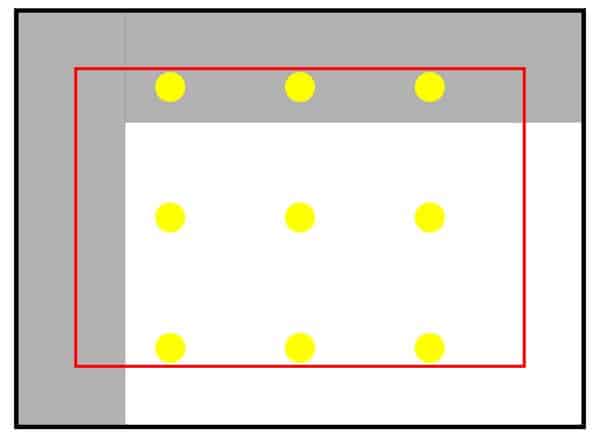If you’re a regular reader of my blog, you’ll know that I often talk about how difficult it is to select a suitable LED bulb. The LED market is extremely oversaturated, so there are millions of different options to choose from.
Unfortunately, hard work doesn’t end there.
Once you’ve chosen a bulb, the next step is placement. Where you place, your LED spotlights can make or break a room.
Well-placed lights will uniformly illuminate the area, enable localized tasks, and create ambiance. Poorly-placed lights, whereas, will result in hotspots and dark spots.
The optimal position for LED spotlights depends on a variety of factors: the size of the room, the height of the ceiling, and how the room is used. Generally speaking, spotlights should be spaced equal distances apart and 1 meter away from ceiling edges.
Have you ever heard the phrase “nothing worth having comes easy“? Well, this applies to LED spotlight placement.
Luckily, I’ve done some of the hard work for you. Keep reading for my comprehensive guide on spotlight placement. By the end of this article, you’ll think it’s a piece of cake, I promise!
How To Space Out Spotlights?
Before you start thinking about the layout of your spotlights, you need to know how far apart to space them. Accurate spacing ensures that light is evenly distributed throughout the entire room.
The primary consideration here is the beam angle of your chosen bulb. The beam angle is a measure of the spread of light being emitted.
Most spotlights have beam angles between 25 and 60 degrees. Narrow beams have a smaller, more intense cone of light, making them ideal as task lights. Wide beams, whereas, illuminate a larger surface area, so they’re often used as general household lighting.
When it comes to spotlights, the beam of light emitted by one spotlight should overlap with the next beam by a third. If the spacing is wider, you’ll end up with unattractive dark patches in your room.
The second thing to think about is ceiling edges i.e., where your wall meets the ceiling.
To put it simply, if you position your spotlights too close to the wall, you will create shadows around your room’s edge. In turn, this will make the room feel smaller. Therefore, your spotlights should be spaced 1 meter away from your ceiling edges.
Alternatively, if you’d prefer a more specific answer about spacing, use this formula:
Spotlight spacing = Ceiling height / 2
Using this method, if your ceiling height is 260cm, your spotlights should ideally be spaced every 130cm.
Ideal Number of Spotlights
Now that you understand spotlight spacing, it’s time to calculate how many spotlights you’re going to need.
In the past, this was set out in wattage. That is, multiplying the square footage of a room by 1.5 would dictate the total wattage required to illuminate the room.
But due to the development of energy-efficient LEDs, wattage is no longer an accurate measure of brightness.
Instead, the brightness of a bulb is measured in lumens (lm). So the calculation needs to be rephrased to focus on the total lumens required to illuminate a room.
If maths isn’t your forte, then fear not! I’ve done the hard work for you.
Step One: Calculate the square footage of your room.
To do this, simply multiply the length of your room by the width. So if your room is 20 feet long and 15 feet wide, the calculation is 20 x 15 = 300.
Step Two: Determine the foot-candle recommendation for your room.
You’ve probably never heard of foot-candles, but they’re a measure of how bright a light is when you’re one foot away from its source.
The number of foot-candles you need depends on the purpose of your room. For example, a kitchen will require more foot-candles than a bedroom, because it is a task-orientated area.
To find the foot-candle recommendation for your room, check out this article by Larsons Electronics.
Step Three: Multiply your room’s square footage by your foot-candle requirement.
This will determine the total number of lumens you need in your room. If your room is 300 square feet and needs 30 foot-candles, you will need 9,000 lumens.
Step Four: Divide the total number of lumens by the lumens produced by a single spotlight.
If your chosen spotlight bulbs have a lumen output of 650, the calculation is 9,000 / 650 = 13.8. Therefore, you’ll need 13 or 14 individual spotlights to provide the necessary amount of light.
What Grid Is The Best For Spotlights In The Kitchen?
A lot of people believe that the kitchen is the heart of the home. It is a multi-functional space, used for both cooking and entertainment.
Kitchen lights can be divided into three main categories: task lights, accent lights, and ceiling lights.
As the name suggests, task lights are used to illuminate areas where you carry out tasks i.e., your countertops. Accent lights, whereas, are used to create visual interest in a room.
But the most important of these three categories are ceiling lights. If your ceiling spotlights do not follow a clear, uniform pattern, your kitchen will have an unsettling atmosphere.
So let’s talk about how to create a perfect spotlight grid for your kitchen.
The first thing you need to do is pick a starting point.
Think about the layout of your kitchen – is there a particular area that you want light directly overhead?
If so, start here. If not, start in the middle of the room.
Now you can use the spacing calculations from earlier to arrange the lights outwards. As a reminder, spotlight spacing is your ceiling height divided by 2.
Furthermore, your spotlights should be 1 meter away from your ceiling edges.
The final plan should look something like this:

How To Position Spotlights In Bathroom
Another area that people often struggle with is the bathroom. In reality, positioning spotlights in a bathroom is not dissimilar to arranging spotlights in a kitchen.
Start by thinking about how you use the room – would you benefit from a spotlight positioned above your mirror? Would a spotlight directly above your bath be too harsh when you’re trying to relax?
Find your focal point and create a grid going outwards.
The main thing to consider is moisture. Bathroom lights often have additional safety requirements.
For instance, lights inside, above, or 60cm away from a bath, shower, or washbasin must have specific IP ratings.
Just remember that water and electricity are a dangerous mix. If you’re having doubts, please consult a registered electrician.
Also read: How Much Recessed Lighting Do I Need?
Final Words
It’s fair to say that although there are lots of different elements involved, spotlight positioning doesn’t have to be something that you dread.
Using my simple guide and straightforward calculations, spotlight positioning is as easy as pie.
Just remember that no two rooms are the same. So it follows that no two spotlight layouts are the same.
How are your spotlights arranged? What’s your top tip for spotlight placement?
Let’s chat, leave a comment down below.
Looking for an LED bulb but not sure what type you need?
Check out my free bulb picker and select the right bulb within few clicks.



